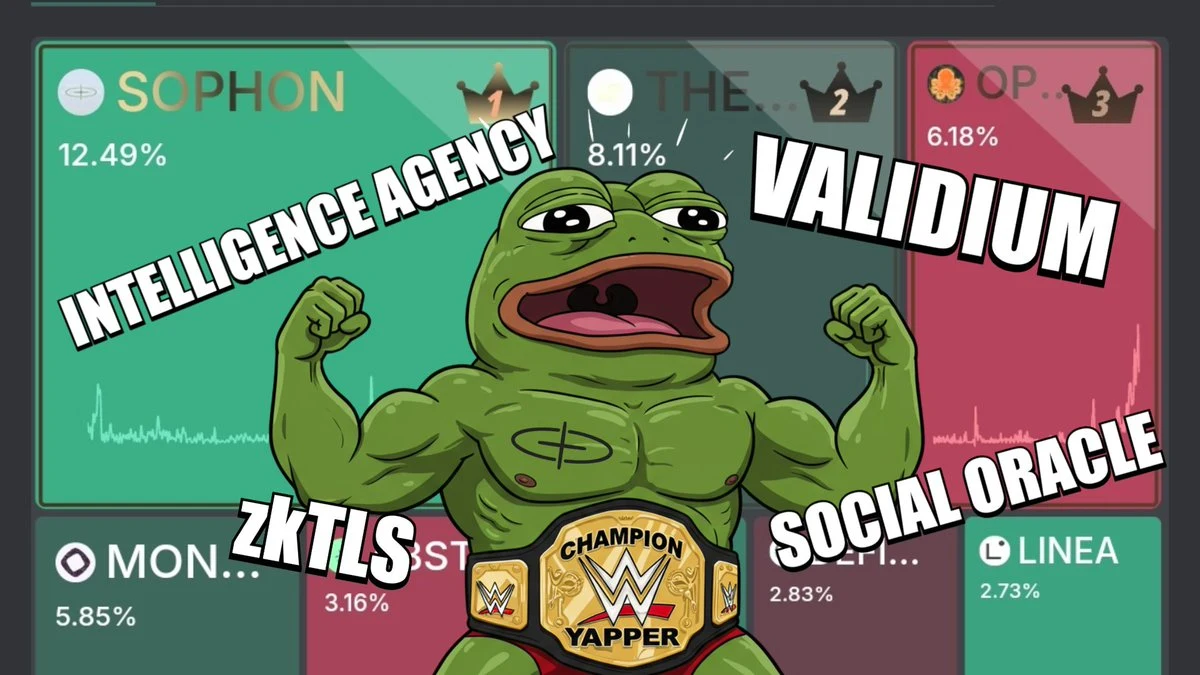
- Details
At the beginning of Q2 2025, in a Layer 2 (L2) blockchain landscape full of technical promises and competing ecosystems, Sophon is positioning itself as the go-to on-chain platform for entertainment, gaming, AI, and social applications. Built on zkSync’s ZK Stack and powered by advanced zero-knowledge rollup technology (zk rollups), Sophon integrates forward-thinking solutions like zkTLS and off-chain data availability to deliver infrastructure tailored for consumer-grade Web3 applications. It aims to enable scalable, low-cost, and private interactions—ideal for Web3 gaming, AI-native apps, and decentralised social platforms.
So what makes Sophon different from other Layer 2 solutions? DWF Ventures took a closer look.
A zkSync Layer 2 for Consumer Crypto and Web3 Entertainment
Built on zkSync’s ZK Stack, a modular toolkit for creating scalable blockchains using zero-knowledge proofs, Sophon positions itself as a dedicated Layer 2 solution for the growing world of consumer crypto. Its goal is to become the leading platform for on-chain entertainment, covering everything from Web3 gaming and AI-powered apps to social platforms and decentralised content experiences.
By combining flexible infrastructure with a wide range of ecosystem initiatives, Sophon is building the foundation for more interactive, affordable, and user-friendly Web3 applications—all while maintaining the speed, scalability, and data privacy that consumer apps demand. This begins with Sophon’s use of zkSync’s ZK Stack and Validium for better scalability.
Scaling with zkSync’s ZK Stack and Validium
As mentioned earlier, one of Sophon’s core architectural features is its use of zkSync’s ZK Stack, specifically the Validium model, a Layer 2 scaling solution that processes data off-chain while maintaining integrity through zero-knowledge proofs. By storing this data on Avail’s modular data availability (DA) layer, which decouples data storage from execution and ensures data is available to verify transactions, Sophon significantly improves transaction speed and cost-efficiency.
This combination makes Sophon especially well-suited for Web3 gaming, decentralised social apps, and other data-heavy consumer crypto applications, where scalability and smooth user experiences are critical.
Seamless Interoperability with zkSync Hyperchains
To foster a more connected and seamless Web3 experience, Sophon integrates zkSync’s Hyperchain framework, boosting Layer 2 interoperability across the wider zkSync ecosystem. This setup allows for frictionless asset and data transfers between Sophon and other zk-based chains such as Abstract, unlocking smoother interactions for both users and developers. Features like shared liquidity pools, account abstraction, and enhanced network customisability give builders the tools to create scalable, adaptable and consumer-focused decentralised apps (dApps), without sacrificing security or usability. As part of its broader modular blockchain architecture, this interoperable design reinforces Sophon’s mission to power the next generation of consumer crypto applications.
Bridging Web2 and Web3 with Sophon’s Social Oracle
Among Sophon’s most forward-looking ideas is the Social Oracle, a conceptual framework designed to bridge Web2 and Web3 by bringing verifiable off-chain data on-chain in a secure, privacy-preserving way. This is made possible through zero-knowledge Transport Layer Security (zkTLS), an emerging cryptographic standard allowing users to prove they’ve interacted with a Web2 service such as Reddit, YouTube, or Spotify, without revealing any sensitive personal data.
zkTLS works by verifying HTTPS-based interactions in a zero-knowledge proof format, meaning platforms don’t need to integrate natively with blockchain systems. In the context of the Social Oracle, this allows users to bring real-world credentials and behaviour on-chain in a trustless and decentralised way.
If implemented, this could power on-chain reputation systems, enable Web2-to-Web3 identity bridges, and introduce tokenised engagement rewards, unlocking more personalised and trust-based Web3 experiences in entertainment, gaming, social apps, and beyond.
The Sophon Intelligence Agency (SIA): Powering AI in Web3
The Sophon Intelligence Agency (SIA) is a $5 million ecosystem initiative dedicated to bringing AI-native applications to life within the Sophon L2 blockchain. Its mission is to make on-chain AI agents an accessible and everyday part of the Web3 experience.
By partnering with Codex and Aethir, the SIA provides developers with decentralised compute credits, enabling them to build and scale intelligent apps powered by machine learning and real-time interaction.
This initiative aims to fuel innovation in areas such as:
- AI-enhanced gaming, including NPCs that adapt to player behaviour and remember interactions
- Social agents capable of understanding dialogue and context
- On-chain learning models that evolve based on user data
A strong example is Nova by Anomaly Games, which features Reddit-trained agents that can engage with both game mechanics and player social dynamics, showcasing the real potential of AI in Web3 entertainment.
On-Chain Metrics and Community-Driven Growth
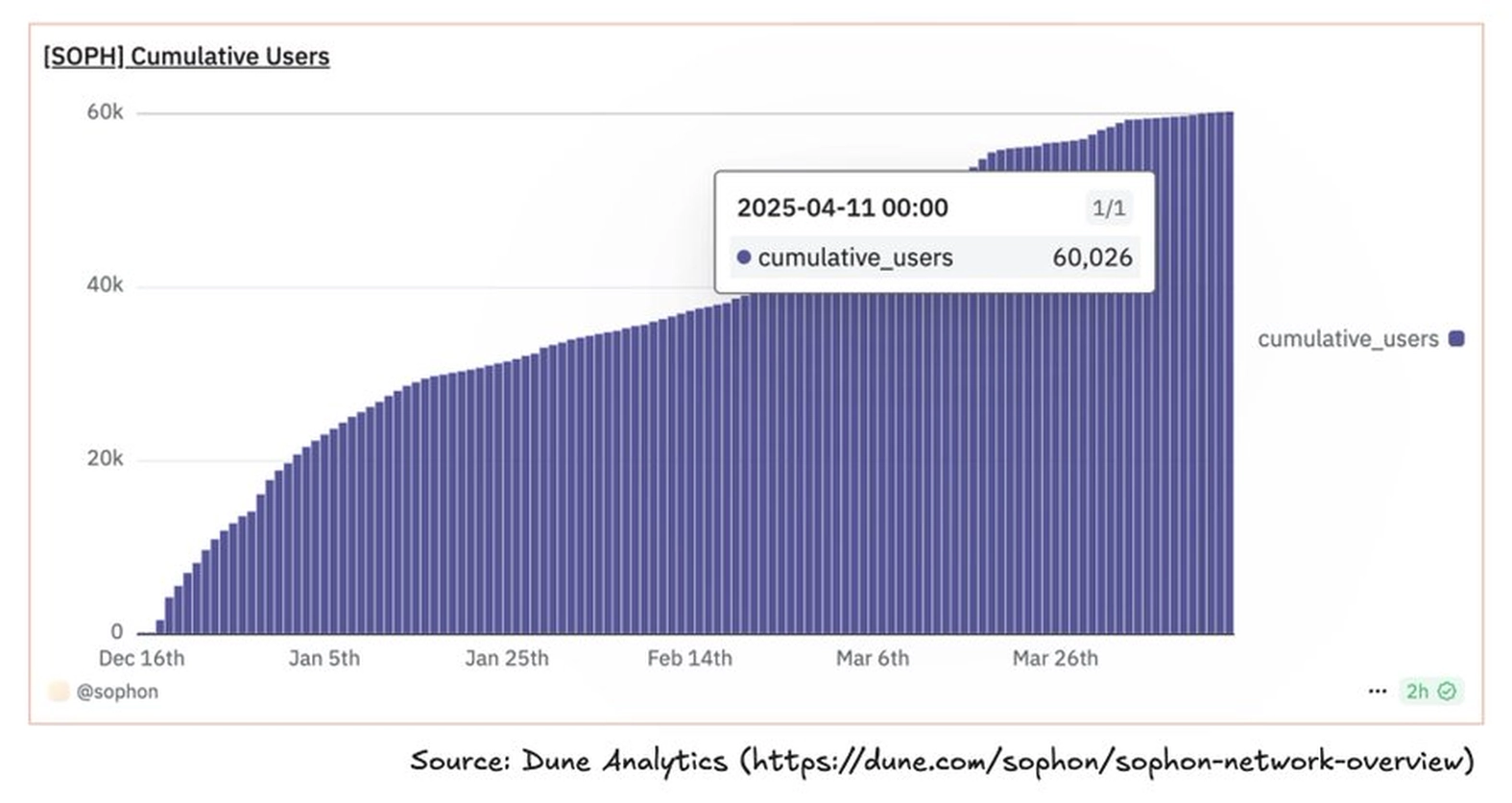
While Sophon’s total value locked (TVL) has declined since its mainnet launch in December 2024, other on-chain performance metrics continue to trend upward. This L2 blockchain surpassed 60,000 users at the beginning of April 2025, alongside a sharp rise in its mindshare ranking on KaitoAI, which is a Web3 analytics platform that tracks community sentiment and project visibility across the decentralised ecosystem.
Driving this user growth is the launch of the Yapper Launchpad, a community rewards campaign built around Web3 engagement. Hosted on KaitoAI, the project incentivises users who consistently post, write, or share insightful content about Sophon, promoting authentic conversations and expanding awareness of the network.
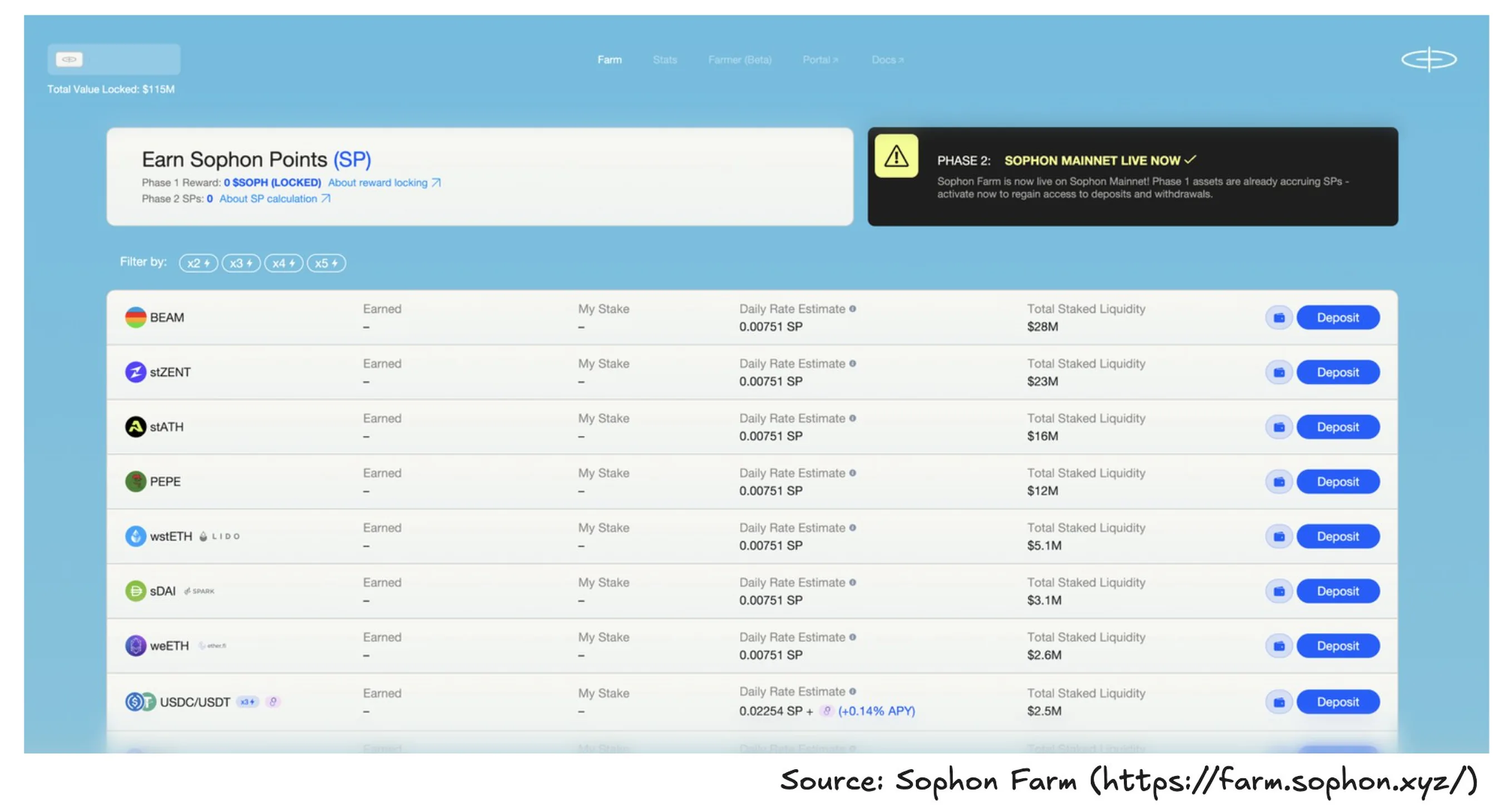
In addition to content-based rewards, Sophon also offers crypto incentives for on-chain activity via farming. Here, users can deposit supported assets and earn participation points, which are expected to convert into Sophon’s native token in future airdrop-style distributions. Together, these programmes play a central role in Sophon’s community-first growth strategy and help strengthen long-term participation in its broader Web3 ecosystem.
Conclusion
Sophon stands out with its focus on consumer crypto, combining Web3 entertainment, on-chain gaming, AI-driven apps, and social platforms into one purpose-built ecosystem. Built on zkSync’s ZK Stack with Validium, Avail, and Hyperchain interoperability, Sophon delivers scalable, low-cost infrastructure without sacrificing speed or flexibility. Solutions like the Social Oracle and the Sophon Intelligence Agency highlight its vision for integrating Web2 identity, zero-knowledge privacy, and decentralised AI. With growing adoption and incentive programs like the Yapper Launchpad and farming, Sophon is quickly becoming the Layer 2 of choice for user-first Web3 experiences.
At DWF Ventures, we’re closely tracking Sophon’s evolution and the ecosystem it’s building. If you're building on the future of entertainment, AI, or social in Web3, contact our crypto venture fund to explore potential partnership and investment opportunities.

- Details
In early 2025, Movement Network Foundation officially launched its public mainnet beta, introducing its modular Layer 2 (L2) solution to the wider developer and user community.
But with over 100 Layer 2 solutions already in the market, what makes Movement different? DWF Ventures took a closer look, let’s dive in.
Introduction
Movement, the secure and scalable blockchain, is built on a modular architecture that integrates the Move Virtual Machine (MoveVM) alongside the Ethereum Virtual Machine (EVM). This means that developers can write smart contracts in both MoveVM’s Move and EVM’s Solidity languages, making Movement one of the first Layer 2s to offer a unified development environment for two ecosystems – enabling the creation of more scalable, efficient, and secure decentralised applications (dApps).
This positions Movement as a bridge between high-performance Move-based blockchains like Aptos and Sui, and Ethereum ecosystem’s robust liquidity and user base. This combination lays the groundwork for how Movement is built and operates at a technical level.
Key Movement's Technologies
The technical architecture behind Movement is built on the Move Stack—a flexible framework designed to support hybrid smart contract execution and seamless interoperability. To handle data availability, it integrates with Celestia, a purpose-built blockchain, as its modular data availability (DA) layer.
The Move Stack consists of three key components:
1. Move Executor
The Move Executor is responsible for processing all incoming transactions from the mempool. It identifies whether a transaction is written in Move or Solidity, then converts it accordingly for execution on the Move Virtual Machine (MoveVM). This hybrid execution model supports parallel processing, helping improve throughput and reduce latency, which is particularly useful for performance-heavy use cases in gaming and DeFi.
2. Decentralised Shared Sequencer (DSS)
Instead of relying on a centralised sequencer, Movement uses a Decentralised Shared Sequencer to process transactions. Experts believe that shared sequencing is a critical solution for rollup-based L2s that will allow them to deal with issues such as MEV exploits, in particular sandwich and frontrunning attacks. This design reduces the risk of censorship and ensures greater network resilience. Built on a proof-of-stake consensus, Movement’s DSS also supports multi-asset staking, giving validators the flexibility to secure the network using different tokens.
Additionally, the DSS helps enable cross-rollup interoperability, opening pathways for cross-chain liquidity pools and asset transfers between Layer 2 ecosystems.
3. Fast Finality Settlement (FFS)
Movement’s Fast Finality Settlement mechanism is tailored for applications that demand quick, reliable transaction confirmations. By merging optimistic rollup principles with additional economic security, FFS delivers low-latency settlement for use cases such as high-frequency trading and real-time microtransactions in gaming. The FFS includes postconfirmations, building on the hot topic of preconfirmations, which the Ethereum community started actively discussing throughout 2024.
This Movement blockchain’s technical foundation has supported early adoption, with over 160 crypto projects currently building within the ecosystem.
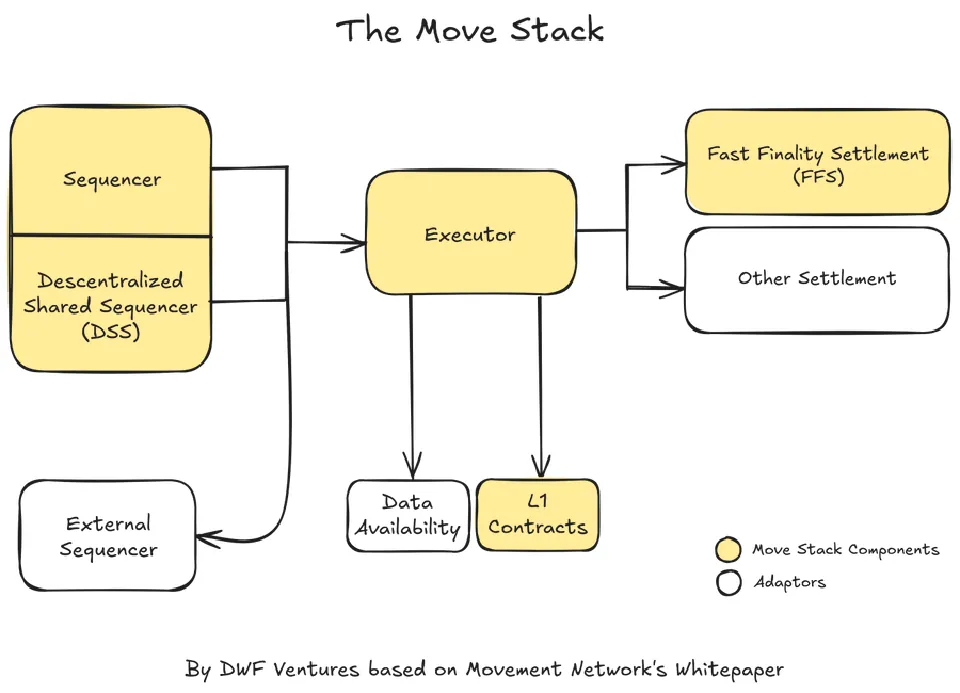
Movement Ecosystem Growth
In the lead-up to mainnet, as we’ve mentioned, Movement has already onboarded over 160 projects, with the most traction in DeFi, infrastructure, and real-world assets (RWAs). Recent ecosystem partnerships, such as the one with ERC3643, reflect a growing interest in institutional-grade applications.
This activity is driven by a strong combination of ecosystem tools and community-focused incentives. The Movement Foundation supports builders with grants and infrastructure, while the in-house accelerator, Move Collective, guides teams through development and go-to-market. One of the most notable initiatives is the Cornucopia airdrop program—among the largest of its kind—which helped the project secure $233 million in TVL and reward early contributors.

The Co-Founder of Movement Labs, Rushi Manche, emphasises that Movement is a community-first blockchain, with 60% of its native cryptocurrency (MOVE) supply allocated to its users. With consistent ecosystem engagement, visible support for builders, and a bottom-up approach, Movement continues to grow from within. However, it still may face several potential challenges.
Challenges and Considerations
The Move programming language, though technically advanced, presents a learning curve that may slow developer onboarding compared to more widely adopted languages like Solidity and Rust. On the infrastructure side, the use of a shared sequencer and parallel processing promises improved throughput, but early community feedback has pointed to issues such as transaction delays and bridge performance, raising concerns about real-world scalability. Additionally, maintaining ecosystem momentum will require continued incentives, strong project onboarding, and sustained market interest.
With these challenges in mind, what’s on the roadmap?
Movement Roadmap: What Comes Next
With the mainnet beta only recently launched, Movement’s roadmap remains in its early stages, and several tools and features outlined in the whitepaper are still under development. To maintain momentum and address challenges around scalability and ecosystem growth, the team has outlined several key initiatives.
These include:
- $250 million Cornucopia Rush, a liquidity programme aimed at supporting early DeFi projects;
- Parthenon V2, which introduces gamified incentives to encourage user participation;
- MoveDrop, a token distribution campaign scheduled for April to onboard new contributors.
Additional ecosystem initiatives are also planned to support ongoing activity and retention. Backed by investors such as Polychain Capital, and YZI Labs, Movement is now entering a crucial phase focused on scaling adoption and delivering on its modular infrastructure vision.
Conclusion
The launch of Movement Network’s public mainnet beta marks an important step in the evolution of modular Layer 2s. By combining the speed and safety of the MoveVM with EVM compatibility, alongside features like fast finality and shared sequencing, Movement introduces a new approach to building scalable applications within the Layer 2 landscape.
With dozens of crypto projects already building on Movement, strong community support, and a clear roadmap ahead, Movement is well-positioned to become a foundation for a new L2 ecosystem, similar to giants such as Coinbase’s Base or Optimism. The next months will be important in showing how the network can scale, improve performance, and keep developers and users engaged.
At DWF Ventures, we’re enthusiastic about the Movement Network. We are always looking for teams leveraging its unique technology to drive innovation.
If you're building something groundbreaking, feel free to connect with our crypto venture capital firm.
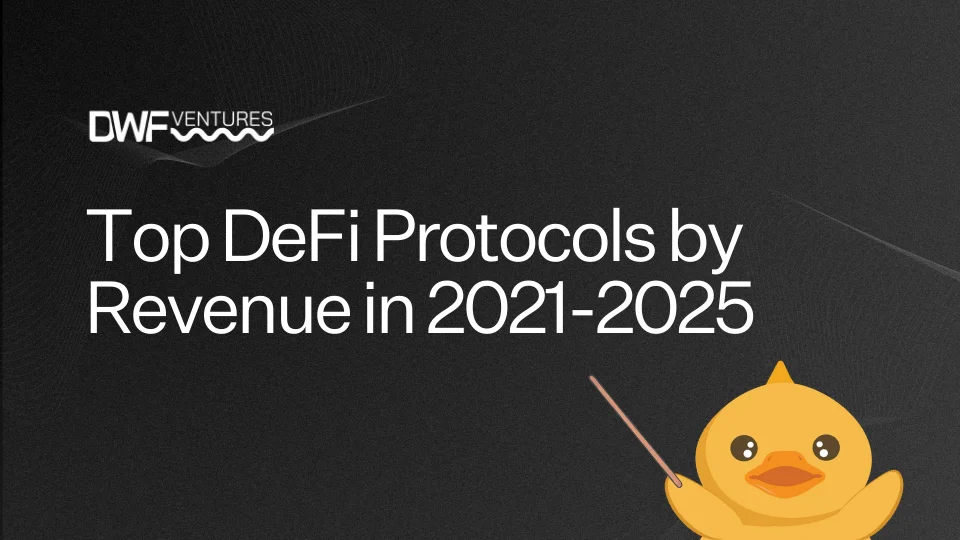
- Details
When the crypto market experiences downturns, users often return to fundamentals, focusing on protocols that generate real revenue. This trend is especially relevant in DeFi, where economic sustainability and transparent metrics become key success factors.
DWF Ventures analysed historical data from DefiLlama to identify the top revenue-generating protocols from 2021 to the present. This analysis reveals major trends, highlights successful models, and offers insights into what might come next.
Top 10 Protocols by 90-Day Rolling Fees as of 17 Feb 2025. Video by DWF Ventures.
2021: DeFi Summer and the Liquidity Wars
Let’s start with the foundations of DeFi’s growth. The DeFi Summer of 2021 marked a surge of activity. The Ethereum mainnet remained at the centre of operations, primarily involving trading and swaps. During this time, platforms like Uniswap, SushiSwap, and PancakeSwap became market leaders.
A phenomenon of yield farming, a DeFi mechanic where users are able to lock tokens in a liquidity pool and earn rewards from fees paid for swap operations, was also a crucial aspect. It led to the popularity of the vote-locking model that allows users to vote on future token emissions. Convex Finance, known for its role as a decentralised exchange and automated market maker protocol for low-slippage trades, emerged as a notable player. Similar protocols began emerging on Fantom (now Sonic Labs) and Avalanche. This wave of competition led to the so-called Curve Wars — a race for crypto liquidity where different protocols offered the highest yields, greatly benefiting end users.
But as the DeFi landscape continued to evolve, new trends emerged, and certain protocols turned out to be the top fee generators, consistently capturing value from user activity. But why are fees such a critical metric for assessing success?
Why Are Fees So Important in DeFi?
So how do we measure that revenue and assess a DeFi protocol’s true impact? One of the most reliable indicators is the fees they collect for swapping crypto via liquidity pools. In DeFi, fees show how much a protocol is really being used and how valuable it is. Unlike metrics like TVL (Total Value Locked) or user counts, fees are harder to fake or inflate.
They also help value tokens, similar to how the price-to-earnings (P/E) ratio works for stocks. Investors are paying more attention to this metric because, as mentioned, TVL, or user counts, can be inflated or drop drastically within a very short period.
2022: NFTs, Staking, and Black Swan Events
In 2022, token trading slowed down, but NFTs took the spotlight. Marketplace platforms like LooksRare and OpenSea became popular as major brands and users explored new ways to earn money through NFT flipping, staking, royalties from secondary sales, and play-to-earn games.
Staking also grew in popularity as users searched for alternatives to yield revenue models. Lido Finance, a liquid staking protocol, became a key player by allowing users to stake assets like Ethereum and receive transferable tokens (e.g., stETH) that earn staking rewards.
Later, when Ethereum transitioned to the Proof-of-Stake (PoS) model in September 2022, demand for liquid staking grew even further.
Even with big crises like the Terra's UST depegging and the FTX collapse, DeFi protocols continued to generate fees, proving that reliable revenue generation is a strong indicator of resilience.
2023: MEV and Real Revenue
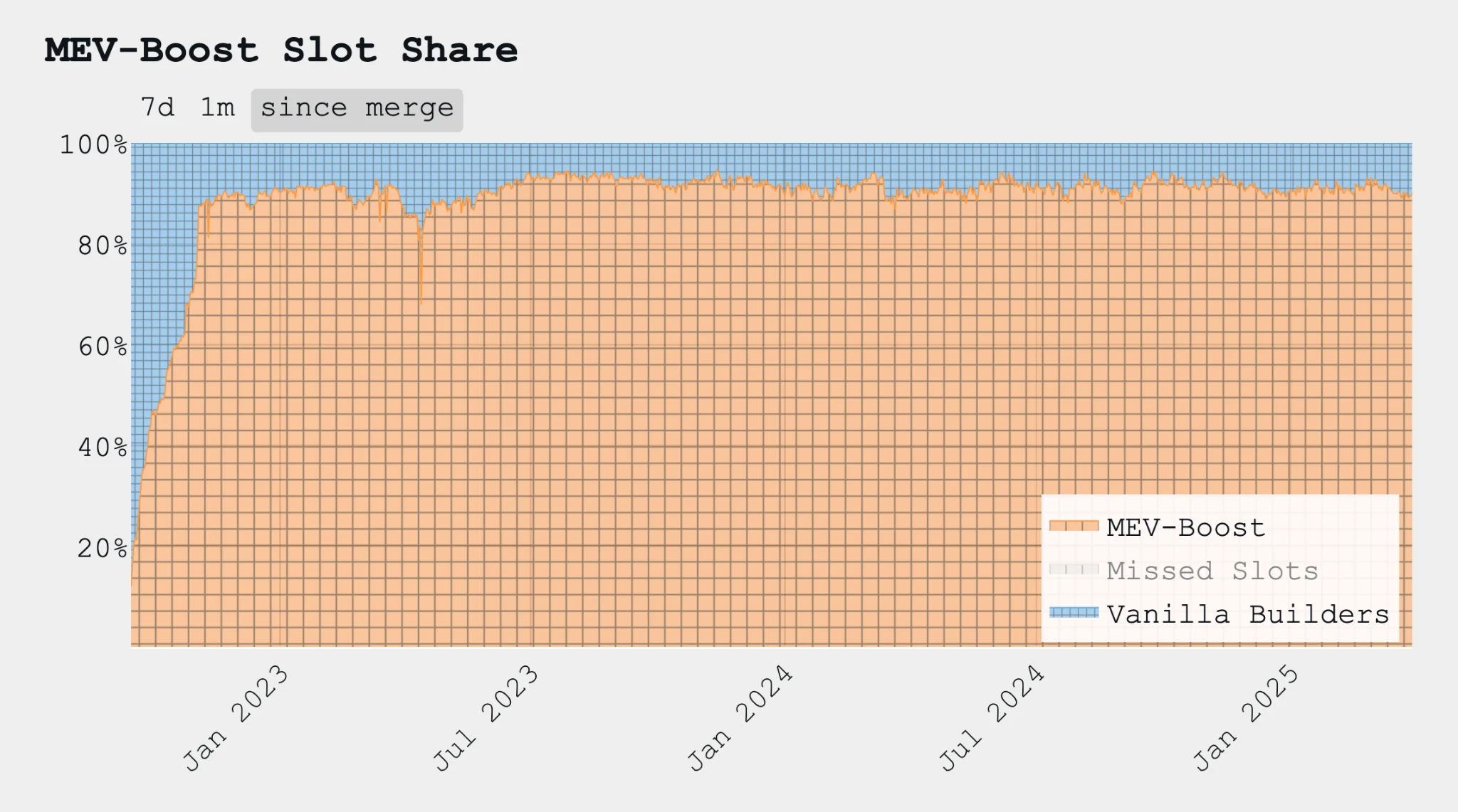
As liquid staking gained traction, users increasingly prioritised protocols that could generate real, sustainable revenue.
After the Ethereum Merge, Flashbots gained attention with their MEV-Boost tool, created to tackle a long-lasting issue of the Maximal Exctractable Value (MEV) exploit in Ethereum. This solution allowed validators to outsource block building to searchers, resulting in exponential revenue growth. According to MEV-Boost Dashboard, more than 90% of validators adopted this tool.
Following the Black Swan events of 2022, including major depegs and exchange collapses, users began focusing on protocols with proven, reliable revenue models. This shift in focus led to a surge in popularity for platforms like GMX, which generates revenue primarily through trading fees, and Aave, which earns revenue through interest payments from borrowers. Additionally, SocialFi protocols like Friend.tech emerged with a fresh concept that allowed users to trade social profiles, sparking discussions about new monetisation strategies and social interaction within Web3.
2024: Solana Takes Over
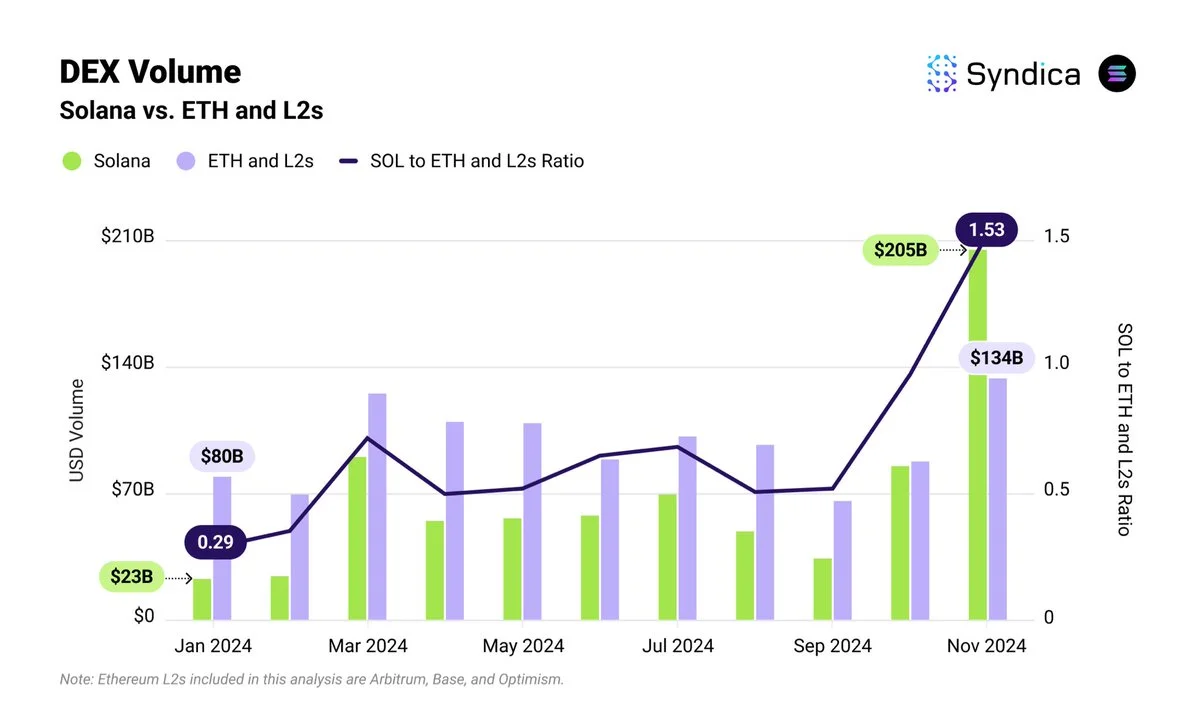
Building on the momentum of revenue-focused protocols, the DeFi landscape began to shift toward new ecosystems offering unique advantages. In 2024, activity began shifting from EVM chains to Solana, where trading and liquid staking became dominant.
Jupiter Exchange, a decentralised exchange aggregator on Solana, and Jito Network, the first MEV-powered and largest liquid staking pool on Solana, emerged as leading protocols.
Another standout application, Pump.fun, established itself as a prevailing player in the memecoin market. By leveraging Raydium Protocol’s liquidity pools and automated market maker (AMM) infrastructure to facilitate trades, Pump.fun not only enhanced its own visibility but also drove liquidity and trading activity to Raydium.
At the same time, synthetic dollar protocols also gained traction. Ethena, built on Ethereum, introduced USDe, a synthetic dollar designed to be a scalable, crypto-native solution. It works by hedging Bitcoin, Ethereum, and Solana assets using futures contracts and holding stablecoins like USDC and USDT. Meanwhile, Sky.money serves as a non-custodial gateway to the decentralised Sky Protocol, which allows users to convert their DAI into USDS while offering incentives like the Sky Savings Rate (SSR) and Sky Token Rewards (STRs).
2025 and Beyond: What’s Next?
As synthetic dollar protocols and Solana’s dominance continue to shape DeFi, new blockchains are emerging with the potential to disrupt the landscape.
Protocols like Berachain’s Proof of Liquidity and new applications from MegaETH and Monad could become significant players as they mature.
For new protocols to stand out, they need to offer superior performance or bring something entirely new to the market. Demonstrating real revenue generation will remain essential to maintaining relevance.
Conclusion
The success of established DeFi apps proves that consistency and reliability are essential. Platforms with strong trading or yield models continue to thrive because they offer dependable experiences that build user trust and foster loyal communities.
For newer apps to succeed, they must go beyond existing solutions, either by improving performance or introducing entirely new experiences. As DeFi evolves, only those offering truly valuable and innovative features will secure their place in the market.
If you are building in the space of derivative protocols, feel free to contact DWF Ventures to discuss potential partnerships with our crypto venture capital fund.

- Details
The arrival of MegaETH public testnet marks a new chapter for EVM-compatible Layer 2 (L2) protocols, such as Base, Blast or based rollups, in 2025. With public access to its testnet now open, the project promises up to 20,000 transactions per second (TPS) and blocktimes as low as 10 milliseconds — a major leap in performance. A mainnet launch is on the horizon, so the question arises: what makes MegaETH different, and which projects are already taking advantage? DWF Ventures dived in.
Introduction
To understand why MegaETH is special, we need to begin with what it fundamentally is. Built as an Ethereum L2, MegaETH bridges the gap between blockchain infrastructure and the speed and flexibility of traditional cloud computing. Its core differences include not just high transaction throughput but also abundant computing resources and real-time processing capabilities — laying the groundwork for entirely new types of applications.
Node Specialisation
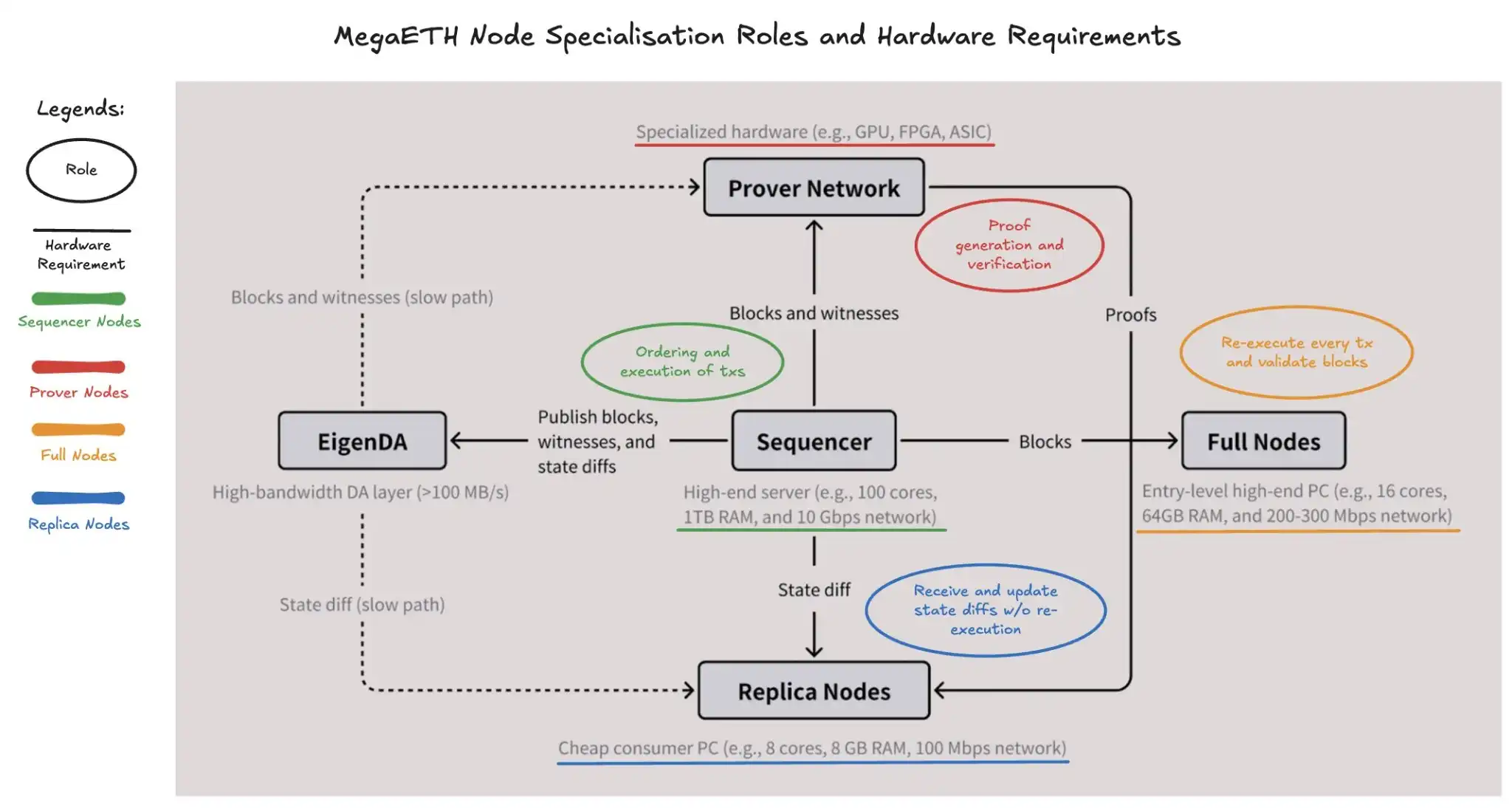
One of the defining innovations behind MegaETH is node specialisation. Unlike traditional blockchain models where every node is responsible for all network tasks, MegaETH separates these roles into distinct functions: Sequencer, Prover, Full, and Replica nodes. Each is optimised for its specific job, reducing inefficiencies and dramatically improving scalability without compromising on decentralisation.
There are four main node types in the MegaETH network:
- Sequencer Nodes: high-end servers (e.g., 100 cores, 1TB RAM, 10 Gbps network) that order and execute transactions, then publish blocks, witnesses, and state diffs to the rest of the system. They form the real-time processing backbone of the L2.
- Prover Nodes: these rely on specialised hardware like GPUs, FPGAs, or ASICs to generate and verify zero-knowledge proofs. They’re crucial for proving the validity of transactions and ensuring the integrity of the network.
- Full Nodes: These act as verifiers of the system; using high-end consumer-grade PCs (e.g., 16 cores, 64GB RAM), they re-execute all transactions and validate blocks, ensuring that everything published by sequencers and provers checks out.
- Replica Nodes: Lightweight participants that use cheap, accessible consumer PCs (e.g., 8 cores, 8GB RAM). These nodes receive and update state diffs without having to re-execute transactions — helping decentralise data availability and improve redundancy.
Inspired by Ethereum’s “Endgame” Vision
This architecture aligns closely with concepts proposed in Vitalik Buterin’s "Endgame" vision for Ethereum. He argues that while block production may become more centralised (since it needs powerful hardware), we can still keep blockchains trustless and open by making block validation easy and decentralised. This can be done using tools like fraud proofs, ZK-SNARKs, and data availability sampling so that anyone can verify that blocks are valid without needing to process everything themselves. MegaETH puts these ideas into practice with specialised node roles, making it easier for more people to join the network and help keep it secure. It’s a real-world example of how Ethereum rollups can scale without losing their core values of decentralisation and censorship resistance.
Performance Boosts
But node specialisation was just the beginning. MegaETH also introduces performance-boosting features such as Just-in-Time (JIT) compilation, which speeds up smart contract execution, and a reimagined state trie that allows data to scale without additional cost. These upgrades aren’t just technical — they represent a step-change in capability, laying a foundation for serious mainstream adoption.
And that brings us to the ecosystem already forming around MegaETH. The platform’s architecture has empowered builders across sectors to develop applications previously thought impossible on-chain. From finance to gaming, MegaETH’s flexibility is already unlocking real innovation.
Ecosystem
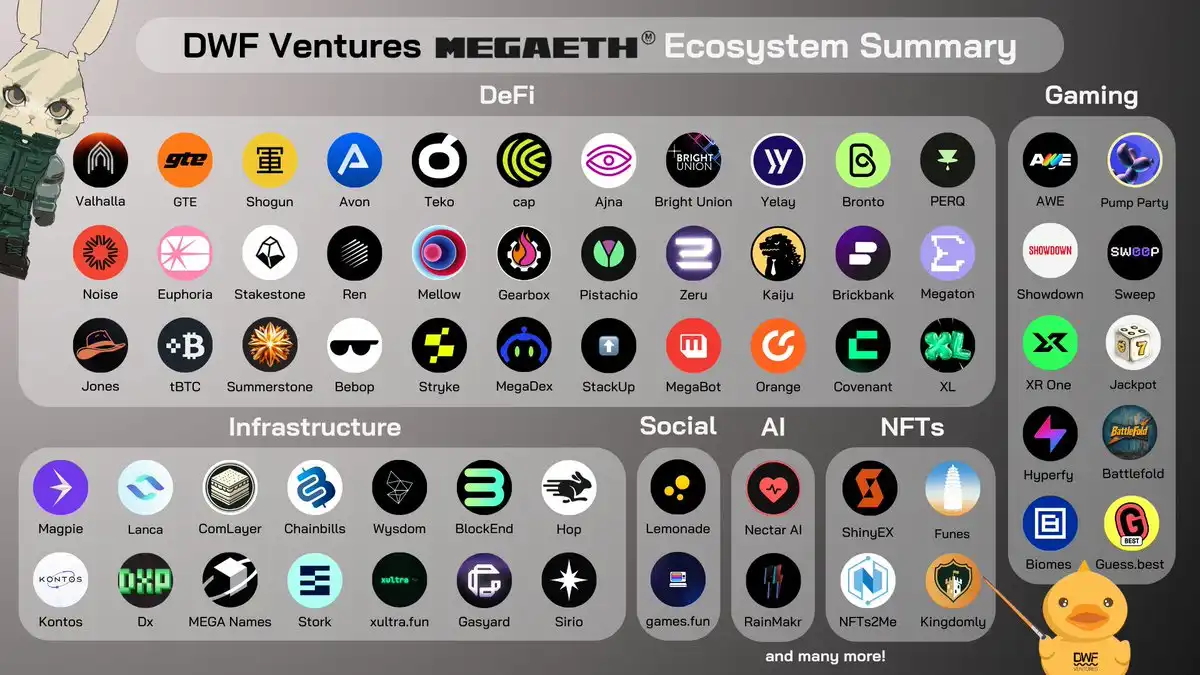
In DeFi, projects like Noise are introducing markets where trends themselves become tradable assets, driven by collective mindshare. In infrastructure, Hop Network is developing a fully on-chain VPN optimised for privacy and ultra-low latency — pushing the boundaries of privacy, speed, and security.
When it comes to gaming and entertainment, Pump Party supports live, interactive gameshows where users can livestream, chat, and win real prizes — all on-chain. Meanwhile, Lemonade is building an all-in-one platform for on-chain event creation and community management, tapping into the growing demand for decentralised social tools.
The rise of AI and digital identity also finds a home here. Nectar AI lets users craft AI companions tailored to their imagination, while Funes serves as an on-chain museum, preserving 3D models of the physical world and building a living digital archive.
Testnet Participation
Developers and users can already experience this ecosystem firsthand on the MegaETH testnet, which is live and growing. While not all advanced features are fully activated yet, the testnet allows for high-load testing and exploration of the core functionality that will define the mainnet. It’s a promising sandbox for the performance to come.
Conclusion
With the next wave of Ethereum scaling unfolding before us, MegaETH stands out not just for its throughput but for its thoughtful architecture and real-world readiness. This isn’t just faster infrastructure. It’s the infrastructure for the next generation of applications.
DWF Ventures Investments
As MegaETH accelerates toward launch, DWF Ventures is actively tracking its development. We’re interested in teams that are pushing the boundaries of what’s possible with Web3 technology. If you are building something interesting, feel free to reach out to us.

- Details
With most altcoins underperforming in the current market, both institutional and retail traders are searching for alternative ways to generate income. One increasingly popular approach is yields, the return or profit generated from staking digital assets.
Pendle Finance is reshaping DeFi (Decentralised Finance) by introducing yield tokenisation, which enables users to trade, hedge, or lock in future yield independently of the principal of an asset. This mechanism is offering ways to onboard institutional liquidity to operate on-chain. Onboarding institutional liquidity to operate on-chain is crucial for enhancing market depth, improving efficiency, and increasing overall stability in DeFi, ultimately bridging the gap between traditional finance and decentralised markets.
Pendle's Performance and Growth
Pendle has experienced exceptional growth, with its TVL (Total Value Locked) surging 20x — from $230 million to $4.4 billion between 2023 and 2024. This growth has been largely driven by the rise of restaking since 2024. Restaking is an emerging concept in DeFi that allows users to reuse their staked assets to secure additional protocols or networks, effectively compounding their yield opportunities. Instead of staking assets like ETH once and earning a single yield, restaking enables users to leverage the same assets multiple times to generate additional rewards.
By interacting with Pendle, users can also receive airdrops from projects such as EigenLayer and Renzo, making it an attractive platform for DeFi participants.
At its peak, Pendle recorded $6 billion+ in TVL and $5 million in monthly revenue.
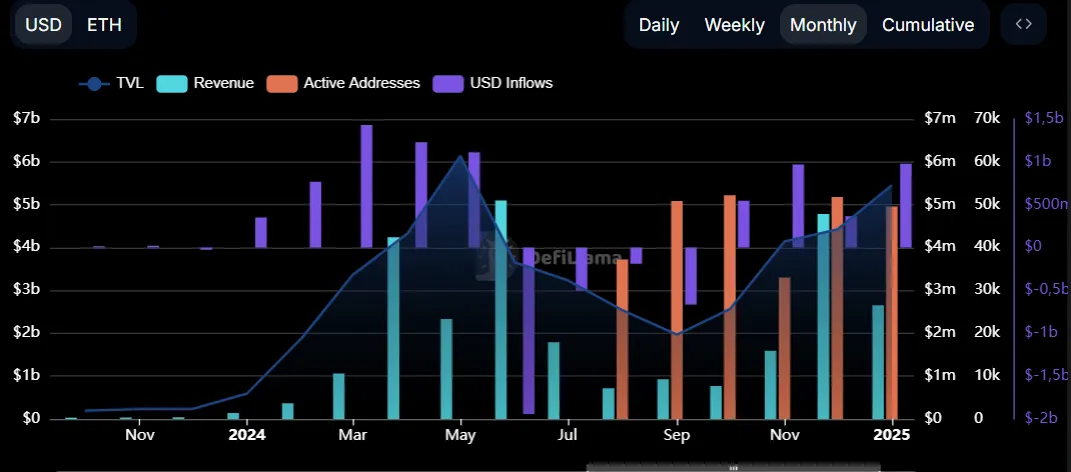
What is Yield Tokenisation?
Yield tokenisation allows users to trade, hedge, or lock in future yield independently of the principal. This unlocks new opportunities for capital efficiency and risk management.
How does it work?
- Pendle wraps yield-bearing tokens (e.g., stETH) into SY (Standardised Yield) tokens, making them compatible with the Pendle AMM (Automated Market Maker).
- SY tokens are then split into two tradable assets:
- Principal Token (PT): Represents the underlying asset’s value but does not accrue yield over time. At maturity, PT can be redeemed for the original asset, and the use case is ideal for those who want to buy assets at a discount and hold until maturity for a fixed return.
- Yield Token (YT): Represents the right to claim future yield. YT holders receive all yield payouts until expiration, but the token itself expires at maturity. Yield tokens are suitable for traders seeking leveraged yield exposure or those looking to hedge against yield fluctuations.
This structure allows users to choose how they interact with yield — locking in fixed returns, speculating on future yield, or optimising their portfolios.

Example: How Yield Tokenisation Works with stETH
To illustrate, let’s consider how an investor might use Pendle with stETH (staked ETH):
1. Monetising Future Yield
- Alice deposits 10 stETH into Pendle, receiving:
- 10 PT-stETH (representing her principal)
- 10 YT-stETH (representing future yield)
- She immediately sells her 10 YT-stETH for 0.5 ETH in Pendle’s marketplace, effectively locking in an upfront profit.
- Since YT-stETH entitles the holder to the yield generated by 10 stETH, the buyer (Bob) is now entitled to these yield payments.
- This allows Alice to realise her future yield today, rather than waiting for it to accrue over time.
2. Hedging Against Yield Fluctuations
- Yield rates in DeFi can be volatile. If Alice expects stETH yield to decrease, selling YT-stETH protects her from potentially lower returns.
- Bob, on the other hand, is betting that yield rates will remain high or increase, making YT-stETH a profitable purchase for him.
- This creates a market for yield speculation, where different risk appetites can be balanced.
3. Yield Collection & Redemption at Expiry
- Suppose the annual yield on stETH is 7%:
- Bob, who holds 10 YT-stETH, earns 0.7 stETH over the year.
- Alice, who sold her YT-stETH, does not receive any yield but still retains her 10 PT-stETH.
- At expiry, Alice redeems her 10 PT-stETH for her original 10 stETH, fully recovering her principal.
This mechanism allows users to monetise their future yield and hedge against changes in yield rates.
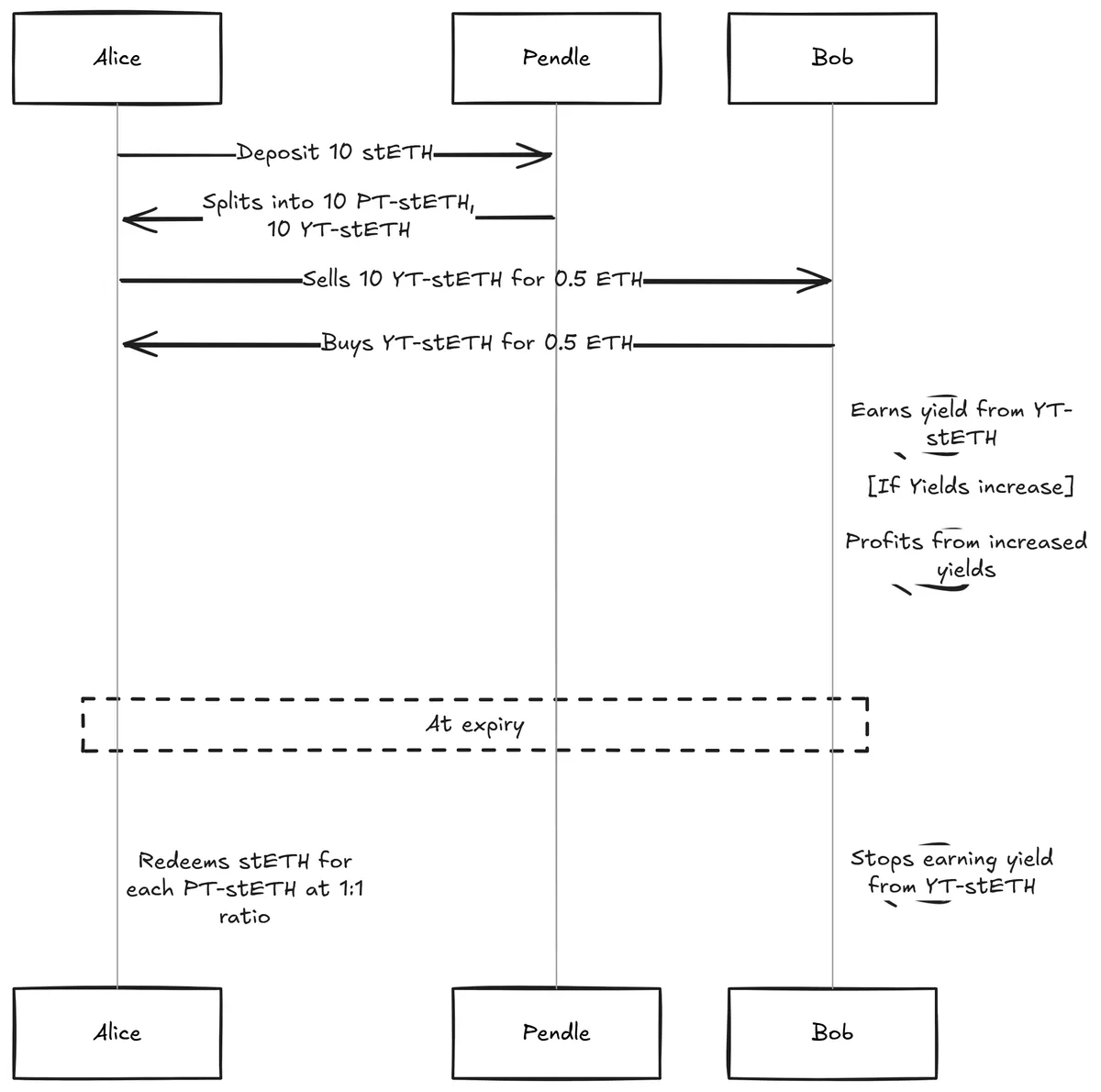
Why Pendle Matters in This Market
In the current environment, trading spot or perpetual contracts has been challenging for many participants. Crypto markets are highly volatile, making it difficult for traders to predict price movements accurately, and many assets suffer from low liquidity, leading to wider spreads and slippage, making execution less efficient. As a result, institutions, whales, and retail traders are increasingly looking for yield capitalisation opportunities with assets like BTC, ETH, and stablecoins.
Pendle enables these traders to lock in fixed yields to hedge against market volatility and trade future yield to maximise returns. This flexibility makes Pendle a valuable tool for both conservative and aggressive yield strategies.
Pendle’s AMM and Yield Trading
Beyond yield tokenisation, Pendle’s V2 AMM (Automated Market Maker) plays a crucial role in optimising yield trading.
Pendle’s AMM is specifically designed for trading yield, leveraging the unique behaviours of PT and YT tokens to enhance capital efficiency.
This innovation allows for deep liquidity and efficient pricing, making it easier for users to interact with yield markets.
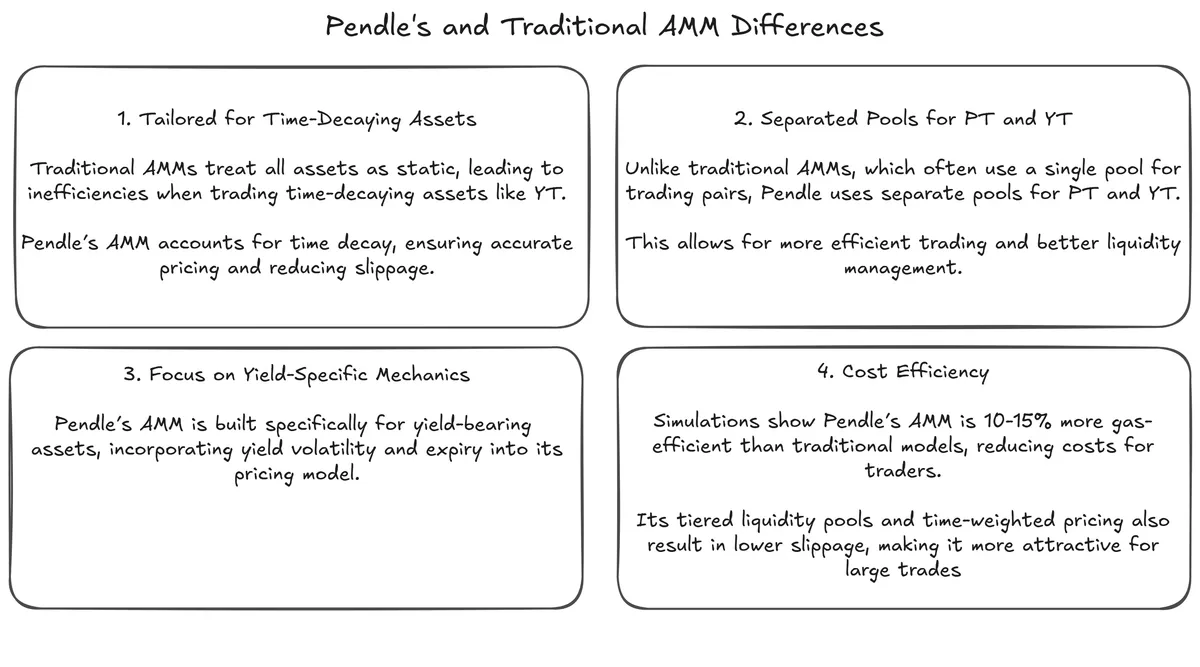
The Road Ahead for Pendle
Pendle aims to become the leading gateway for yield trading across multiple financial sectors. The team has outlined several key developments for the future:
1) Enhancements to Pendle V2
Pendle is enhancing its ecosystem by allowing third parties to create their own yield markets, expanding opportunities for users. Additionally, the platform plans to introduce dynamic fee structures to optimise trading efficiency. Improvements to governance will also be made, giving vePENDLE holders more voting options to shape the protocol’s future.
2) Building Citadels
Pendle is planning to expand beyond Ethereum-based ecosystems by integrating with non-EVM chains such as Solana and TON, broadening its reach across different blockchain networks. Additionally, the platform aims to develop KYC-compliant products to cater to institutional investors seeking regulatory-compliant DeFi solutions. To further enhance accessibility, Pendle is also working on Shariah-compliant financial offerings, ensuring that its products align with the needs of diverse global markets.
3) Boros Initiative
Pendle is expanding its capabilities by supporting a diverse range of yield sources, including funding rates, to provide users more opportunities for yield generation. Additionally, the platform is developing advanced tools for hedging and yield optimisation, enabling users to better manage risk and maximise returns in volatile market conditions.
These initiatives position Pendle as a long-term player in the evolving DeFi landscape.

- Details
On the 14th of February, a project “Viva la Libertad” launched the meme token $LIBRA on Solana. In its first hour, the token valuation skyrocketed to a high of $1.16 billion in market capitalisation (~$4.5 billion in fully diluted valuation). However, it subsequently plummeted over 95%, wiping out over $280 million in value from nearly 75,000 individual traders. Dubbed the ‘Cryptogate’ scandal, the launch allegedly involved the participation and endorsement from prominent parties like Argentinian President Javier Milei and Web3 investment firm Kelsier Ventures.
Allegations of insider trading and market manipulation quickly surfaced, with some wallets, including that of Kelsier Ventures, making over $110 million from liquidity provision and sniping the token at launch. This triggered major outburst from the crypto community, and a political crisis for Milei with fraud accusations and calls for a federal investigation.
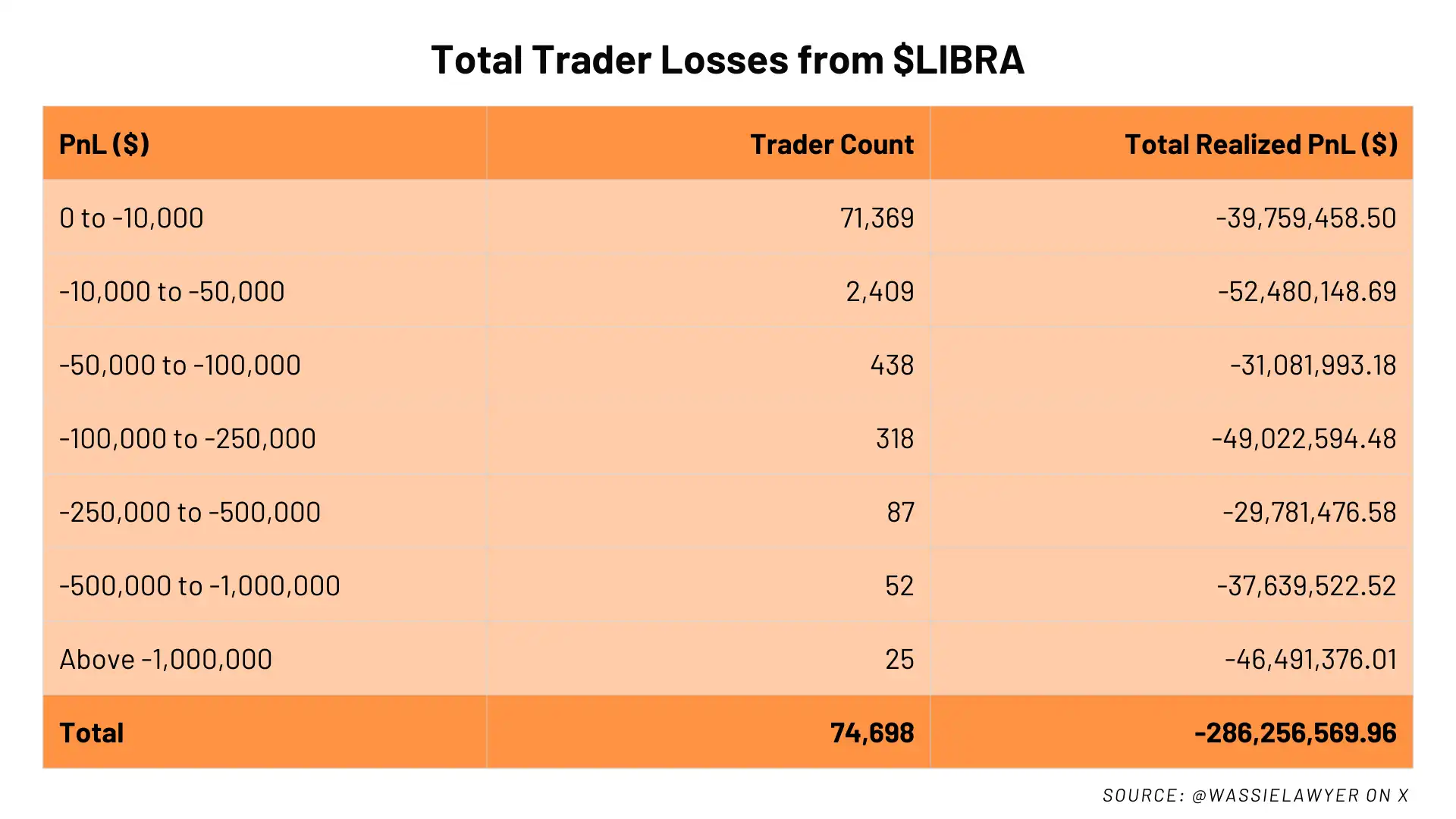
Kelsier’s CEO Hayden Davis’ was also found to have played a part in First Lady Melania Trump’s $MELANIA token launches. These events not only highlight the ongoing issues with influential celebrity-related cryptocurrency launches, but also the ever-pressing need for a more transparent and equitable token launch mechanism in the crypto market.
The History of Token Launches
Since the advent of cryptocurrency, the evolution of token launch mechanisms has undergone much innovation and adaptation, with each new mechanism offering its own traits and advantages.
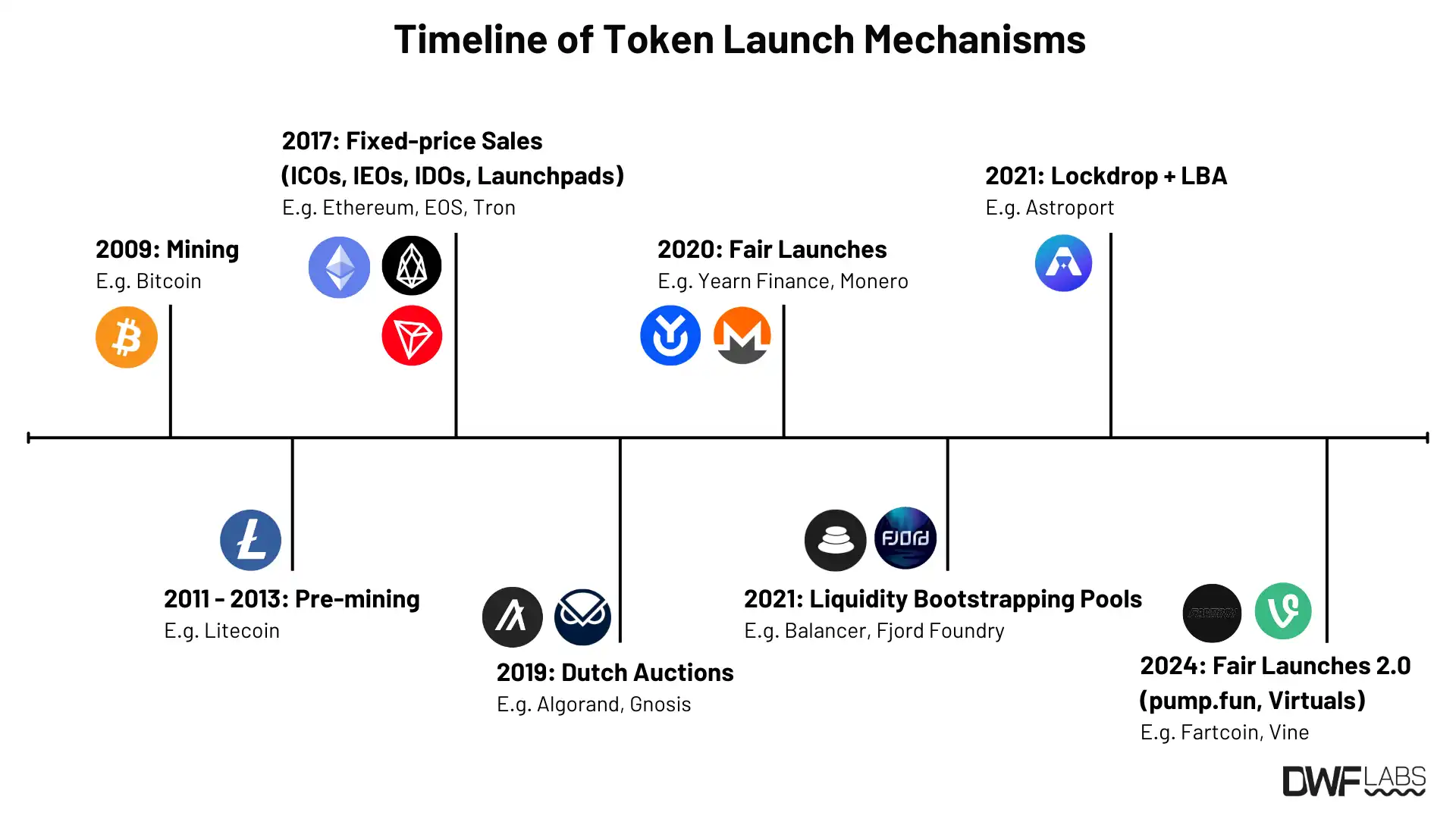
Mining
The earliest method of token launches was mining, first demonstrated by Bitcoin in 2009. Using a Proof-of-Work (PoW) consensus mechanism, it involves network participants (miners) expending computational power to validate transactions and compete for the opportunity to propose new blocks on the blockchain, receiving rewards in the form of newly minted tokens in return if successful. However, mining has been associated with significant challenges, including miner centralisation, high energy consumptions and environmental concerns. This has led to regulatory efforts aimed at mitigating them, such as restrictions on carbon-intensive mining operations in certain regions.
Pre-mining
Following mining, pre-mining emerged as a method to allocate tokens to different stakeholders of a project (team, advisors, investors, etc.) prior to the token’s public launch. Initially, pre-mining was criticised as a potential tool for dishonesty and centralisation. Transparent allocation has since improved this practice. Projects can now benefit from development funding to build a strategic reserve for future initiatives and incentivise early contributors. However, the market still lacked an effective means of distributing tokens to retail participants.
Fixed-price Sales
The Initial Coin Offering (ICO) boom of 2017 would bring about the first popularized solution — fixed-price sales, where tokens could be sold to the public at a predetermined price. This provided a simple way to calculate token allocation based on funds raised and gave participants an equal opportunity to purchase tokens early on. Despite this, fixed-price sales are not without problems. Mispricing of tokens triggered volatility post-launch while large investors still have the upper hand because they can buy up more tokens. Regardless, ICOs were instrumental in raising capital quickly between 2017-2018.
But by 2018, it was obvious that these unregulated token sales would face increased skepticism due to the large presence of scams. This led to a rise in alternative forms of fixed-price sales such as Initial Exchange Offerings (IEOs) and Initial DEX Offerings (IDO). These new offerings involving third parties help add a layer of verification and legitimacy to projects.
Dutch Auctions
Implemented by projects like Algorand and Gnosis, Dutch auctions introduced a new way for the market to price tokens. This approach starts with a high price that gradually decreases until a reserve price, allowing users to buy in at any price they deem the token to be worth. The final token price can be higher than the reserve price if demand exceeds supply before the time period is over. Compared to fixed-price sales, Dutch auctions are more inclusive and can help to reduce post-launch price volatility. This method is best utilised when the founding team is confident that the public market is able to make an informed decision about the valuation of the asset they are selling.
Fair Launches
Exemplified by Yearn Finance and Monero, fair launches aimed to distribute tokens transparently and equitably, with no one group having significant control over the protocol. This is a step further from fixed-price sales and Dutch auctions as all parties, including the founding team, would be required to acquire tokens at launch through purchasing or participating in liquidity mining. The community will then get the power to decide on the direction of the protocol, ensuring that early supporters are always aligned with the protocol’s growth. This could be a double-edged sword as while it ensured decentralisation, it could also skew decisions towards the hands of a few ‘whales’ who can buy up token supply to directly impact voting decisions.
Liquidity Bootstrapping Pools (LBPs)
Liquidity Bootstrapping Pools (LBPs) on Balancer and Fjord Foundry emerged as a new innovation on Dutch Auctions, using dynamic weight ratios to determine token prices and distribution. Starting with a heavily weighted ratio (e.g. 99% tokens to 1% stablecoins) that gradually adjusts over time to a balanced ratio, this creates a natural price discovery process. Whales are discouraged from large early purchases while enabling projects to launch with minimal capital requirements. LBPs also offer project teams considerable control over sale parameters, including the ability to pause swapping when needed. However, they also present challenges, such as complexity for participants and the need for careful parameter design to prevent manipulation.
Lockdrop + Liquidity Bootstrapping Auction (LBA)
The lockdrop + LBA is an innovative token launch mechanism that is designed with a two-phase process to promote fair distribution and sustainable price discovery. Phase 1 involves participants pre-committing collateral to the protocol, receiving protocol tokens based on the duration and size of their commitment. These would remain locked until the end of Phase 1. Phase 2 is the price discovery stage, where previously locked tokens are granted to participants who can choose to deposit them into a liquidity pool for additional rewards. The LBA is typically divided into two further parts: in Part A, users can deposit tokens and stablecoins but only withdraw stablecoins, while in Part B, stablecoin liquidity withdrawal is gradually restricted to lock liquidity into the pool. At the end of the auction, remaining tokens and stablecoins are used to determine the final token price, and participants receive LP shares proportional to their deposits.
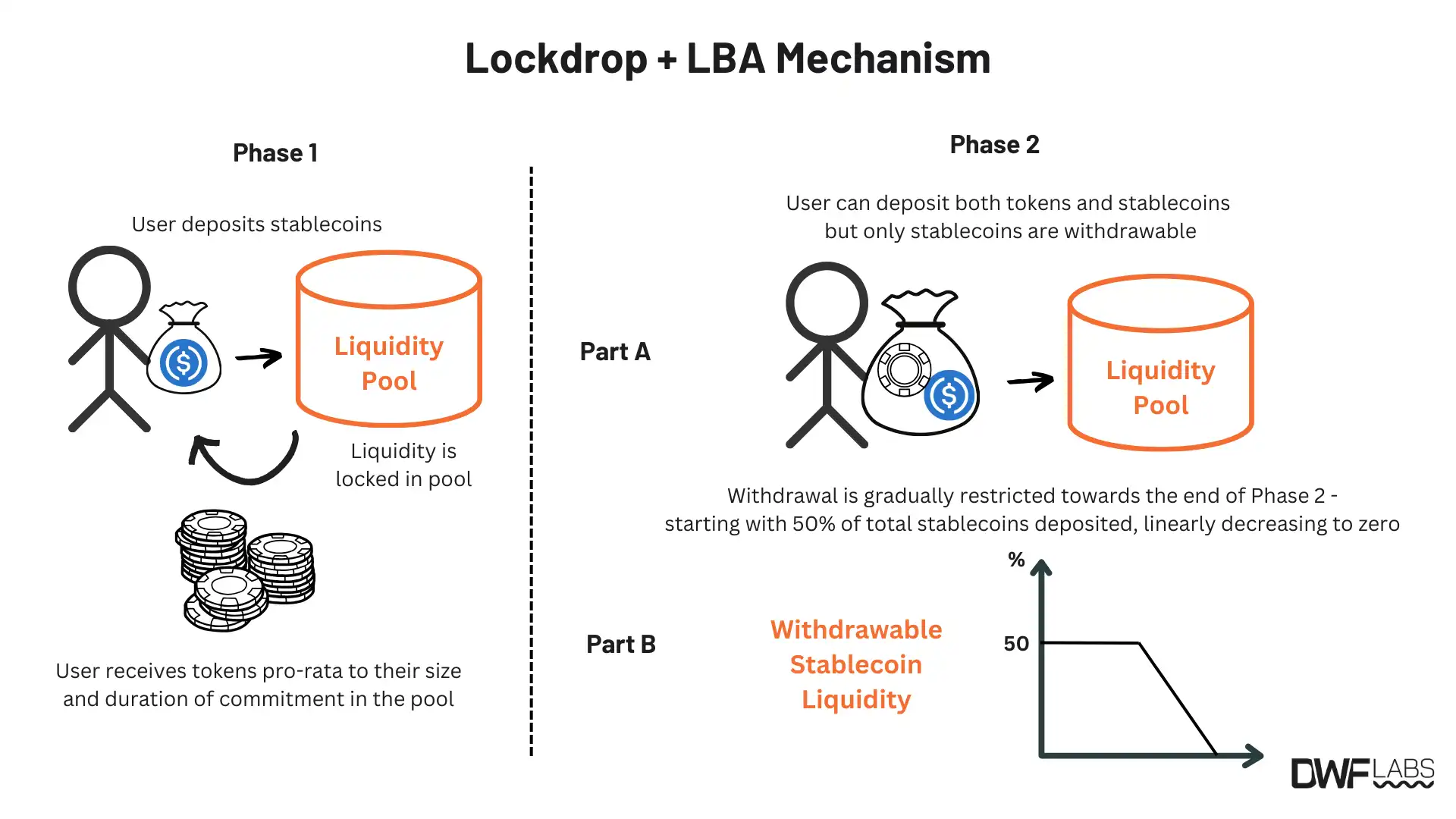
This model offers several advantages, including reduced initial price volatility, fair token distribution, and a mechanism that discourages immediate selling pressure. It also helps projects gauge community commitment and attract long-term alignment. However, this is not without challenges. The complexity of the process may deter some participants, and the locked assets can limit short-term liquidity.
Fair Launches 2.0
As users became disillusioned with low float high FDV tokens, we saw a shift back towards more decentralised and ‘community-first’ fair launches. Fair Launches 2.0 can be defined as decentralising the token creation and trading process coupled with innovative accelerating mechanisms. Pump.fun entered the scene in January 2024, introducing a ‘one-click’ launchpad for anyone to launch a token. Tokens will only be tradable on pump.fun’s platform, until they surpass $100,000 in market cap, whereby they will ‘graduate’ from the platform and have a liquidity pool seeded on Raydium with $17,000 of liquidity.
This whole process reduced the time and knowledge needed for token creation, automated liquidity management and made it much more transparent as compared to before, signalling a shift of power from centralised entities. It also reduced the risk for creators to near zero in terms of putting upfront capital to seed liquidity. Meanwhile, its social elements rallied users together to support what they believe in, as being an early adopter meant significant upside once a token ‘graduates’. This created a flywheel which spurred its exponential growth as token creators are incentivised to launch on pump.fun while users are constantly looking out for the next gem on the platform - ensuring that there is constant demand and supply.
Many other platforms have spawned out trying to replicate Pump.fun’s success, such as flaunch.gg on Uniswap v4. It introduces buybacks and revenue sharing back to users, making it more attractive for users to trade or launch tokens on their launchpad.
Diagnosing Problems and Flaws

The surge in memecoin activity and the rise of new launchpads have highlighted the persistent flaws amongst existing token launch mechanisms. High-profile exploitative incidents involving tokens like $LIBRA and $MELANIA reiterates the need for more comprehensive solutions, as it undermines the industry’s principles of fairness and decentralisation. While the evolution of token launch mechanisms represents a continuous effort to create more equitable and efficient mechanisms, it is clear that some issues have yet to be resolved.
Insider Trading due to Information Asymmetry
Insider trading remains rampant in token launches . In the $LIBRA launch, insiders were given large percentages of token supply while others engaged in ‘sniping’, purchasing large amounts of tokens immediately after launch. This was followed by the Argentinian president’s seemingly coordinated endorsement of the token on social media, causing a massive influx of buys from retail participants, inflating the token’s market capitalisation to highs of over $4.5 billion. Soon after, the early buyers were observed to be exiting their positions on-chain, resulting in losses for many new entrants. The online endorsement would then be deleted, causing more sell pressure.
Similarly, $MELANIA saw a single wallet holding 80% of its supply, raising concerns about ownership concentration. The admission by Hayden Davis profiting greatly off $LIBRA and $MELANIA launches underscores the issue on insider access. Coupled with the influence of celebrities and political figures, these cases demonstrate that existing launch mechanisms remain vulnerable to coordinated efforts by insiders.
Bot and Whale Domination
While many modern launch mechanisms strive to minimize bot and whale domination, inherent trade-offs allow these issues to persist. Even in supposedly fair launches, where participation is open to all, sophisticated bots and deep-pocketed whales are still able to acquire a disproportionate share of the token supply. This enables whales to control significant portions of liquidity and trading volume, allowing them to execute coordinated market manipulation schemes which leaves smaller retail participants at their mercy. This results in an unfair advantage, contradicting the initial promise of equal opportunity.
Regulatory Gaps and Enforcement Challenges
Unlike traditional financial markets where front-running and insider trading are illegal and actively prosecuted, crypto markets operate in a regulatory gray area with many ambiguities. This makes it unclear which laws apply and which authorities have jurisdiction, leading to regulatory arbitrage and hindering effective enforcement even when foul play has been identified. Moreover, the pseudo-anonymity of crypto assets and involved parties create data gaps for regulators - further facilitating money laundering through scam launches and exploitation of loopholes without the fear of significant consequences.
Alternatives and New Approaches
The above problems associated with token launches have profound implications for the cryptocurrency industry as a whole, affecting both memecoins and legitimate projects. As retail investors become increasingly wary of entering a space perceived as vulnerable to manipulation and scams, it stifles mainstream adoption and innovation – rendering technological advancements and UX improvements largely inconsequential. Therefore, we propose several comprehensive approaches to address these issues, ensuring that the industry can continue to progress in a positive direction.
Debt Issuance
This method involves projects issuing debt tokens that represent a claim on future revenues or assets. This emphasises on the value proposition of the project and potentially reduces volatility compared to traditional token launches. However, this does expose investors to default risk. Projects must be able to generate positive cash flows, suggesting that this method might be more applicable for established projects with working product and traction, and are in need of secondary fundraising from the public. Though this may limit the upside potential for early investors and requires more complex financial structuring, this serves as a major step in promoting access to sustainable long-term projects.
Liquidity Locking
One approach that has been gaining traction even amongst memecoins, is liquidity locking. Similar to the concept of lockdrops, this involves locking LP tokens in smart contracts for a predetermined period, allowing projects to demonstrate their commitment to their token’s long-term success. This mechanism prevents instant "rugpulls" by developers and serves as a preventive measure against malicious practices, boosting investor confidence, and encouraging long-term alignment from retail participants. This also contributes to ensuring sufficient depth of liquidity for trades, preventing instances of major slippage and even manipulation by large holders. Though this might limit projects in responding fast to the markets, more customizable solutions that allow for different mechanisms can be experimented with to identify a better balance for both projects and investors. Some examples include lock splits, incremental locks, milestone-based unlocks and more.
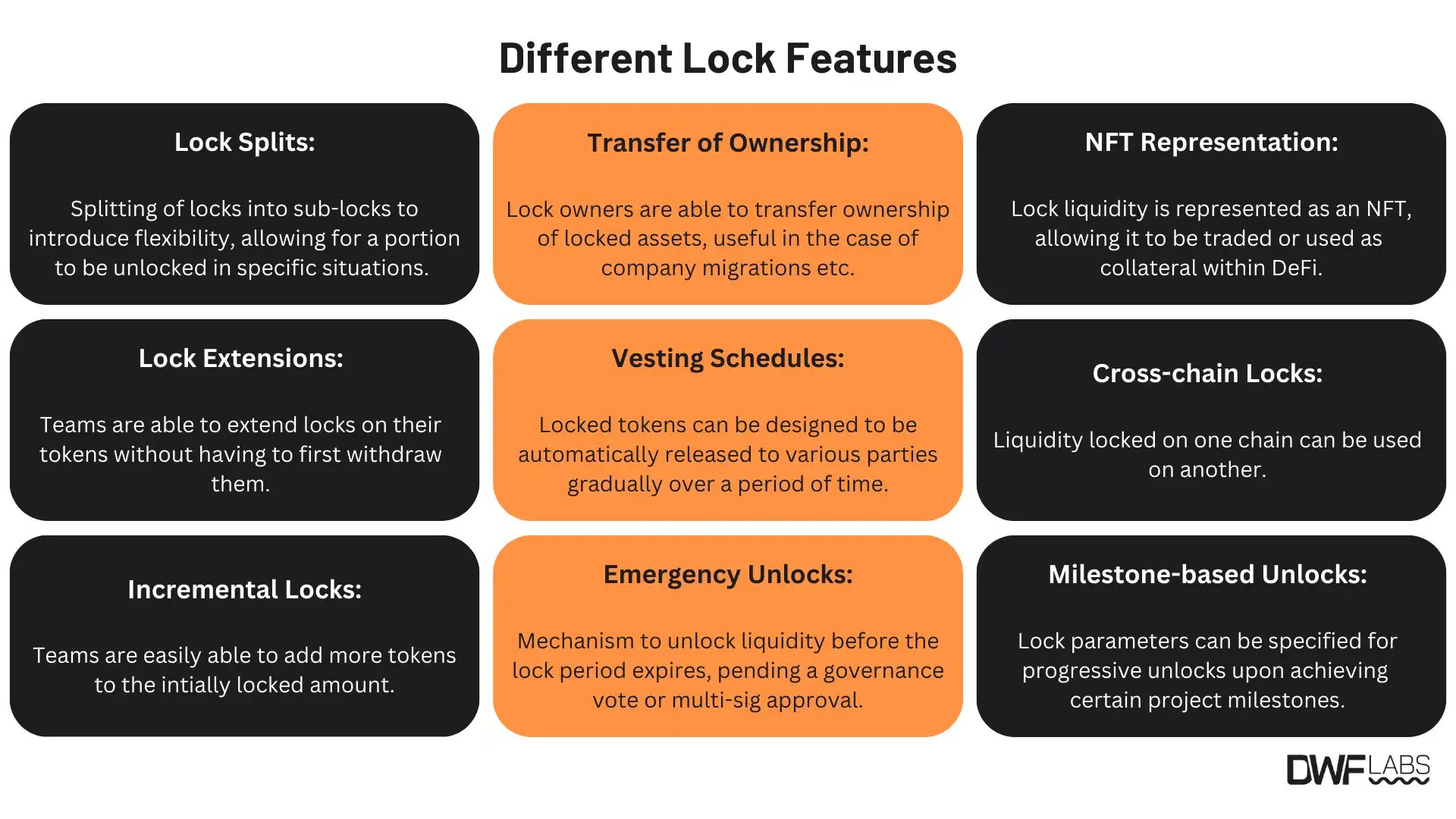
Launch Restrictions
While eliminating bot and whale participation entirely is likely unattainable, strategically implemented launch restrictions can significantly mitigate their impact on token distribution. One potential approach is to impose maximum bid or purchase limits per wallet, preventing whales from accumulating a disproportionately large share of tokens in a single transaction. Furthermore, integrating private social verification methods, such as requiring Twitter account authentication, could reduce bot activity. While restrictions are necessary, they should not impede decentralisation efforts or limit community engagement. There should still be a balance between individual privacy and protecting the interest of the community - to allow for optimal user experience that enhances the industry’s reputation and trustworthiness.
Policy and Regulatory Improvements
To address the persistent issues in token launches effectively, several policy recommendations and regulatory improvements can also be considered. Mandatory disclosures, such as requiring pre-launch wallet transparency would help to serve as a precautionary measure in the case where concentration of token ownership and potential insider trading needs to be identified. Implementation of regulatory frameworks like the EU's Markets in Crypto-Assets (MiCA) regulation is also crucial as it provides clearer guidelines for token issuers and protects investors by establishing rules across the European Union. Alongside this, guidelines addressing the ambiguity surrounding legal jurisdictions would also be extremely beneficial. Enhanced due diligence by launchpads and exchanges before facilitating token sales should also be done to ensure that projects are legitimate and well-vetted.
Conclusion — The Road to a Level Playing Field
This article has charted the evolution of token launch mechanisms, from the foundational principles of mining to the complexities of liquidity bootstrapping auctions, revealing the persistent challenges in each token launch mechanism. Despite advancements aimed at enhancing fairness and decentralisation, high-profile incidents like the $LIBRA and $MELANIA launches reveals the vulnerability of current systems to insider trading, market manipulation, and regulatory arbitrage. These issues not only erode investor confidence but also threaten the long-term stability of the crypto market, disproportionately impacting retail participants.
Looking ahead, the future of token launch practices hinges on the collective efforts of industry stakeholders and regulatory bodies. Policy recommendations such as mandatory pre-launch disclosures, and enforced liquidity locks can provide a crucial layer of investor protection. The implementation of regulatory sandboxes allows for safe experimentation with new launch mechanisms, while international cooperation is essential to address the global nature of cryptocurrency transactions. Ultimately, greater transparency and a commitment to ethical conduct can help us continue to build a more resilient and trustworthy crypto ecosystem.

- Details
What was discussed on the biggest crypto event about Ethereum: trends, emerging ecosystems , and the state of crypto in the U.S.

